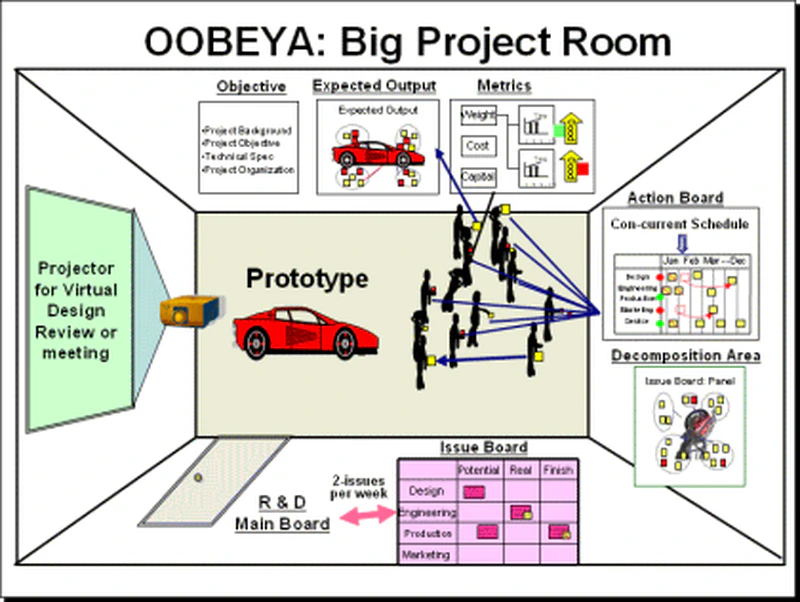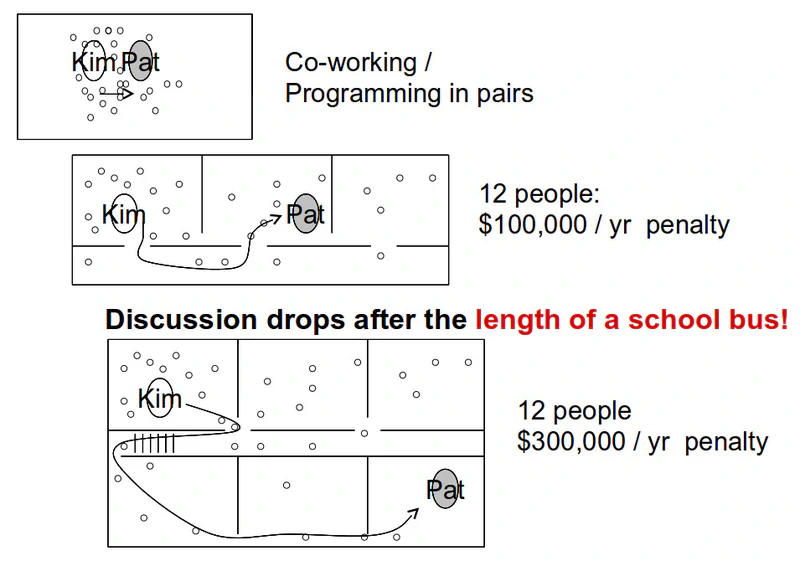After launching the idea of using catastrophe theory, an idea that’s difficult to grasp and apply – I’ll try soon to make it more tangible by associating it with the metaphor of crystal – I’m going to return to much more concrete things like physical organization, in the field.
Recently I was able to conduct two Open Agile Adoption sessions (I’ll tell you about them this week through this blog), and one of the things that strikes me is the concrete aspect of the proposals. You’d imagine that people would ask for decision-making processes, advanced ways of managing communication, etc. But no, not at all, they bring their proposals back to very concrete things, very down-to-earth, but probably terribly effective: having laptops rather than desktop computers, changing the location of the office to have easier access for everyone, grouping project members together, more processor computing power, more disk space, etc.
A container, self-organization
Well yes, I remind you, because I love this phrase from Harrison Owen, “organizing a self-organizing system is not only an oxymoron, it’s especially stupid!”; and human beings, like all living systems, are self-organizing. Therefore, we must absolutely not try to organize them, but give them the means to self-organize more easily, more readily, more quickly. Here we find an idea dear to complexity: the best way to generate emergent practices is to place a container, a framework, constraints, and let the (complex) element flourish within it.
So give your organization, the people who compose it, the means to flourish, to self-organize, by offering them a conducive framework. And don’t look for complications where there are none.
Workspace, openspace, obeya?
To start we can discuss openspaces – here I’m talking about large open spaces with all the desks –. The tendency is rather to ban them. There’s too much bustle and not enough focus by theme. Moreover, very strangely, in these large spaces the “product” or “project” teams are not grouped together as often as you’d think. Instead, we should prefer what Toyota called Obeya.

That is, a “project” room. It brings together all the elements and actors of the project. There’s a strong focus, the container is physically represented. And, adds John Medina, in Brain Rules, memory works better by associating place & subject, and thus problem-solving. You’ll note that an Obeya offers a very visual approach, with a dedicated wall per theme, I’ll come back to this point below, but it’s also essential.
Openspaces, however, have the benefit of easily circulating information to everyone at once. To not lose this transmission, if you opt for the “project room” option – which I recommend – accompany it with nice relaxation & coffee spaces (with sofas and Persian rugs, that’s my personal crusade, sofas and Persian rugs). Teams shouldn’t be immutable either, we imagine they change from time to time (one member every 3 or 6 months?).
Co-location?
Yes, this probably implies co-location. How many times does it need to be repeated? We’re much better when co-located. And co-located means, if we use the beautiful image from Alistair Cockburn, no more than the distance of a bus (see his graphic below, click to enlarge, which comes from this excellent video).

Unfortunately I no longer know where I read this, and so I can’t give you the reference, but it seems that certain studies even show that being located on another floor is a distance even harder to cross than being in two different cities.
The main question for organizations is a matter of communication. We spend an inordinate amount of time communicating poorly, because for reasons of cost or convenience we decided not to be co-located. This is something that costs very dearly. Both in terms of people’s involvement, quality, time, etc.
Off-shore?
But then, what about off-shore? Off-shore as we usually understand it (or even near shore) combines two problems: the non-co-location mentioned above, and the fact that it’s destined for a very specific task in a project; very often for example, testing, quality assurance, or development. And that’s when disaster strikes. Not content with being unable to communicate (due to distance, but also often language and culture), we blind the external center by giving it no vision, no capacity for self-organization precisely. We lose all commitment and motivation as I mentioned in that previous article, and thus all productivity. As I said, in the book “Mythical Man Month” by Fred Brooks, a “productivity” ratio for engineers is mentioned with a factor between 1 and 10. This factor is for me largely based on the engineer’s capacity for commitment and involvement. With classic off-shore it collapses. Indians, Poles, Tunisians, are naturally neither more nor less intelligent than the French (does it need to be said…!!!), it’s the framework that encourages intelligence, innovation, commitment, involvement, productivity. Add to that the cost of distance… Redo your calculations with your purchases and your talent pools and your off-shore, take the cost of off-shore and multiply by ten or fifteen.
Off-shore can very well be considered if it’s built on a heterogeneous team (3 to 7 people) or department (50 people), with multiple skills (from business, to testing, to deployment, etc.) and co-located. I’m not telling you that you can’t have an organization across several continents, but that each location must have its own meaning and self-organize.
For the numbers 7 and 50 I encourage you to read the agile horde.
Remote work
But then, what about remote work? Remote work is a question that’s handled within the team, with management support if it exists. So it’s a question of self-organization. Depending on the moments, the team should know how to place the cursor in the right place, and this cursor can move. A priori remote work goes against co-location and the obeya. So I don’t envision it full-time, but if someone wants to protect themselves -in peace- at home, if they flourish that way, it will only be better for the team. This agreement is possible within a team. I believe there should be moments when everyone is present together. I’ve read the figure of 60% remote work maximum, it seems coherent to me, but since it’s about self-organization within the team I’m ready to observe all solutions, all options.
In case of remote work, to reorganize communication it’s strongly recommended to place everyone at the same level, meaning that if one person had to work in teleconference via some tool, it’s recommended to place everyone through this tool to guarantee the same level of communication for everyone (even if the four others are around the same desk…). This strengthens trust and aligns everyone. (Don’t be crazy either, I’m only talking about daily or weekly meetings, not throughout the entire day).
Moreover, we observe that distributed teams: one member in each European capital, work better than dispersed teams: the majority of the team in Paris, and two members in Berlin. Particularly for reasons of equal access to information and therefore team dynamics.
Work tools
In all this, instead of generally focusing on the consent process, or how to estimate as accurately as possible, it would be better to focus on liberating people’s capacity. Yes, having more powerful machines generally costs little compared to what it can bring in value. Imagine you couldn’t have your continuous integration platform (I’m talking to IT people), just because of an exhausted server… Think about the cost of a good server compared to the gain of having a continuous integration platform.
It’s the same for walls and physical boards, visual management (the real kind), invest 2000 to 5000 euros and save a project worth ten or a hundred times more.
Same for remote communication tools, because even when the organization opts for classic off-shore, supposedly to guarantee higher costs, it focuses on equipping itself with a failing video-conferencing system, or a dramatically undersized network.
A better network, better tools, good walls, beautiful project/product rooms; co-located teams, self-organized and meaningful, don’t look for complications where there are none.
Series on organizations
0 - premises: Large-scale agile: it’s clear as crystal
1 - thinking about your organization: introduction
2 - thinking about your organization: catastrophe theory
3 - thinking about your organization: in the field